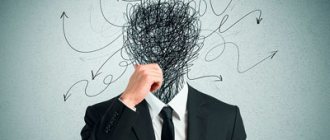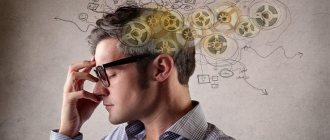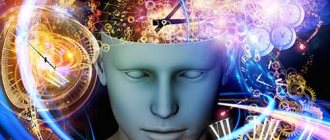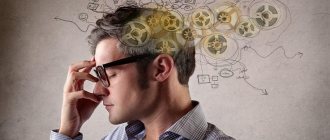The earliest manifestations of confusion and disorientation include a sharp decrease in concentration. During progression, there is a complete disruption of sensitivity to the outside world, memory lapses occur, logical thinking is modified, the patient does not understand what is happening, recognizable memory and full-fledged speech are impaired, and emotional distress occurs. As a result, depression, silence and inactivity of a person are recorded. The psychiatrist must distinguish between these aspects and provide a presumptive diagnosis when communicating with the patient.
What is a confused state?
In this process, the ability to think at an average speed disappears, the clarity and consistency of thoughts is significantly destroyed.
Content:
- What is a confused state?
- Causes
- Symptoms
- What is disorientation?
- Current of development
- Medical classification
- Symptoms of the disease
- Benefits of diagnostics
Signs of the disorder are problems with orientation in space and deterioration of attention. Logical thinking disappears and memory is degraded. The highest signs of the psyche change one by one. For example, only speech recognition may be affected. Memory problems are noted, spatial orientation is impaired. There are two types of confused consciousness, depending on the cause of its occurrence - fast and slow.
Manifestations can be one-time or permanent. Dementia and delirium are signs of the latter condition. The integrative function of thinking at the moment of confusion is absent. Along with the expected change, the patient is often silent, moves little, and is depressed outwardly. Illusions and hallucinations accompany the disease. The first arise because the body incorrectly perceives the stimulus, while hallucinations manifest themselves independently. Each person suffers from the disease differently - the determining factor is the underlying cause of the development of the disorder. Slowness of thinking and inconsistency of logical series are emphasized during the first minutes of conversation. Even non-professionals can notice the initial symptoms.
Psychotherapists divide delirium into several classifications: hallucinatory (the ability to see non-existent information); manic (obsession with aggression); catatonic (inability to fully move); confabulatory (twisting of an obvious fact).
Pathogenesis
To successfully navigate in space, a person must maintain normal cognitive activity, recognize spatial landmarks, mentally imagine and remember space, and distinguish between left and right sides.
When the brain receives visual information, it processes it in the primary projection areas of the occipital cortex. Then it enters the posterior convexital sections, the lateral surface of the temporal lobe. This process allows you to recognize and determine the position of objects.
Short-term memory of space, thanks to which a person moves, is provided by the prefrontal cortex. Consequently, the basis for the pathogenesis of disorientation is the cognitive component, as well as the pathology of the activity of a number of brain structures.
Causes
The following reasons for the occurrence of the phenomenon of confused consciousness are identified:
- traumatic (consequences of penetrating traumatic brain injury);
- in case of brain injury (organ tissues are highly sensitive);
- the occurrence of an aneurysm (an enlarged blood vessel affects neighboring tissues);
- mercury poisoning;
- increased dose of alcohol in the blood;
- drug intoxication;
- effects of neurotropic gas on the respiratory system;
- entry of organophosphorus compounds into the digestive system;
- poisoning with neurotoxic substances – puffer fish, mushrooms, carambola;
- hyperthermia resulting from infectious diseases;
- pain shock during a fracture, dislocation, significant blood loss;
- severe diseases - tuberculosis, encephalitis, diabetes mellitus, all types of hepatitis, acquired human immunodeficiency syndrome at the final stage of development;
- progression of the growth of a cancerous tumor at the last stage - decay (during the process intoxication occurs);
- coronary heart disease, all types of strokes, occurring both unnoticed and obvious;
- myocardial infarction, with pronounced pain and impaired blood flow;
- vegetative-vascular dystonia – dilation of blood vessels occurs in areas of the autonomic nervous system of the body;
- age-related diseases: senile dementia, Alzheimer's disease, marasmus of all types;
- bright emotional outburst;
- hypothermia;
- a period without sleep for a long time;
- oxygen starvation;
- 1st and 2nd degree stunning.
Prevention
To prevent the development of diseases in which confusion and disorientation may develop, it is necessary to follow these rules:
- Eat right, trying to introduce the maximum amount of healthy and vitamin-rich foods into your diet.
- Lead an active life and play sports.
- Get rid of bad habits.
- Regularly train your memory and brain by solving crosswords, puzzles, etc.
- Get proper rest, sleep at least 7 hours a day.
- Conduct preventive blood tests, monitoring sugar levels, cholesterol and other indicators.
- Avoid head injuries.
- Timely and correct treatment of diseases of the nervous system, blood vessels, heart, etc.
Symptoms
For a primary diagnosis, it is necessary to detect the active progress of processes:
- shallow memory lapses (information is lost within a few minutes);
- the patient cannot recognize his loved ones, as well as basic passport data;
- there is no memory of the person’s information field;
- disorientation;
- unconditional changes in mood (an aggressive mood can manifest itself even among close people);
- there is no logical chain in the pronunciation of phrases (pronunciation speed is below average);
- lack of control over the bladder and sphincter (constant urination and defecation);
- Normal sleep is completely disrupted.
Sometimes the cause of such manifestations is cervical osteochondrosis. The clinical picture in this case changes - pain in the cardiac and chest region is added, movement is limited, and there is increased sweating.
Due to internal bleeding, additional aspects appear: excessive sweating; pale skin; black stool; high blood pressure; worsening breathing; tachycardia.
Psychological disorder, in turn, entails inappropriate behavior, aggressive attacks, lack of normal sleep, terrorizing the immediate environment, the emergence of helplessness and the collapse of a clearly established internal model of behavior.
If the patient experiences the changes described above, you should immediately contact your local psychiatrist. Next, a conversation is held, but not in private, but in the presence of a relative. Additionally, blood donation is prescribed for general and biochemical blood and urine tests. An electrocardiogram, ultrasound examination of internal organs, Doppler sonography of all key vessels, magnetic resonance imaging if necessary, and oral consultation with specialists are performed.
General groups of symptoms
The disease distinguishes two groups of disorders: cognitive and neurological.
Cognitive disorders come to the fore, that is, regression of cognitive and thinking functions.
At the initial stage of the disease, memory is primarily affected. At first these are subtle changes. A person forgets some events, individual names and dates, and cannot find the right word to express a thought. The process of assimilation of new knowledge worsens, and it becomes increasingly difficult for the patient to remember and analyze new information.
Gradually, amnestic symptoms increase. The person does not grasp the meaning of what was said, and it becomes more and more difficult to find words. Because of this, his speech becomes meager, his sentences are short and monosyllabic. If talkativeness manifests itself, then it is incoherent; letters in words can be rearranged, words can be replaced. The person himself does not understand the meaning of what he said. Speech impairment leads to difficulties with writing and reading.
Amnesia occurs in the following forms:
- progressive - the patient begins to forget what happened to him recently, and then earlier events;
- fixation – inability to perceive, analyze, store new material, current events. Consciousness in such patients is preserved; they remember well the events of the past, but cannot remember what they talked about with the person 5 minutes ago. Having bought milk, brought it home and put it in the refrigerator, a few minutes later they are going to the store again to buy it, since they have already forgotten that they purchased it;
- Paramnesia is false memories when the patient supplements reality with unreal events. For example, he may pass off as reality events read in a book or seen in a film, and believe that this actually happened to him. Or he simply fantasizes, passing off as reality what did not happen. It is possible that events may shift in time, that is, what happened many years ago is perceived by a person as having happened yesterday.
In addition to memory, other cognitive functions are affected in vascular dementia. Attention is scattered, it is impossible to fix it for a long time. Perception is disrupted. Thinking becomes inflexible. It is difficult to switch from one activity to another.
Often, as the process progresses, patients develop a symptom such as Korsakoff's syndrome, named after the doctor who first described it. It combines several symptoms. First of all, this is fixation amnesia. As already mentioned, the patient does not remember current events, but retains memory of the past. In this regard, he loses orientation in time and space. So-called amnestic disorientation develops.
There are also various variations of paramnesia: doubts about the occurrence of a particular event, their displacement in time, a mixture of fictional and true events.
Against this background, a person gets lost in an unfamiliar environment. He doesn't understand where he is. While in the hospital, he cannot find his bed, but in a familiar environment, at home, he finds his way around perfectly.
What is disorientation?
It is classified as a mental disorder and can cause certain changes in the functioning of the central nervous system. It is divided into short-term and long-term, depending on a number of factors. The patient is unable to describe himself as a person; there is no temporal and spatial orientation. It should not be confused with childhood social disorientation, which is a temporary age-related process. The phenomenon is divided into two types: allopsychic, autopsychic. In the first case, there is an inability to determine location, as well as to separate time periods. In the second case, it is impossible to name the first name, last name, patronymic, date of birth, place of residence. For diagnosis, the right questions are asked and clarity is established. If it is confused, urgent consultation with a psychiatrist is necessary. To be admitted to a psychiatric hospital, the patient's voluntary consent to medical care is required. Impaired consciousness makes it impossible to objectively assess the situation; hospitalization is carried out according to the estimated condition at the time of treatment. Direct relatives and family members can help expedite legal issues.
Losing your balance in the dark
There may be cases of loss of balance in the dark. The disorder may occur due to chronic vestibular dysfunction. Increased symptoms in the dark are due to the fact that in such a situation vision cannot compensate for the defect. As a result, simply going to fetch water at night will cause significant difficulty and often end in a fall. Loss of balance in the dark is caused by drug intoxication, damage to the cerebellum, and disorders in the cervical spine. If the cerebellum is damaged, visual control is not important and the person will constantly experience a feeling of loss of balance.
Current of development
To correctly establish the primary diagnosis, it is necessary to note the causes of the anomaly. Fundamental experts identify the following factors:
- psychological disorders leading to a serious disorder in consciousness;
- stress, nervous overstrain;
- exceeding the norm of ppm alcohol in the blood;
- drug intoxication;
- medications: tranquilizers, antidepressants, sedatives;
- long-term exposure to increased background radiation;
- period of recovery from anesthesia;
- progressive depression;
- Alzheimer's disease;
- senile pseudosclerosis;
- vegetative-vascular dystonia;
- schizophrenia;
- hypoglycemia;
- senile dementia;
- lack of water resources in the body;
- insufficient kidney function;
- epileptic disease;
- malignant brain tumor;
- benign brain tumor;
- hyperthermia;
- infection with encephalitis tick.
Disorientation can be observed during a high-power impact and in a large emotional outburst. With this development, fainting often occurs. A one-time case is not a consequence of the occurrence of pathological processes. However, to be on the safe side, a consultation with a psychiatrist is necessary.
First aid
If consciousness is impaired, it is necessary to provide adequate first aid and, if necessary, call an ambulance. It is important to consider that signs of disorientation may indicate the development of serious illnesses. Sometimes confusion is a sign of a developing stroke . If there is such suspicion, a doctor should be called immediately. If a person has difficulty breathing, they need to remove tight clothing and provide fresh air. It is better that before the ambulance arrives, the patient is in a lying or sitting position and does not change it.
Medical classification
Best materials of the month
- Coronaviruses: SARS-CoV-2 (COVID-19)
- Antibiotics for the prevention and treatment of COVID-19: how effective are they?
- The most common "office" diseases
- Does vodka kill coronavirus?
- How to stay alive on our roads?
Disorientation is classified into radiation, occupational, spatial and social symptoms. Psychiatry identifies the term “autopsychic disorientation” - the lack of perception of personal factors (the inability to reproduce the last name, first name, patronymic, date of birth, that is, identification data). With this phenomenon, the individual’s surrounding world changes, and orientation in it is completely absent. A double perception of the world is noted, a real and imaginary environment is created, alternately visited by the psychological inner world. The full picture emerges after a proper examination by a doctor.
Diet
Diet for the nervous system
- Efficacy: therapeutic effect after 2 months
- Timing: constantly
- Cost of food: 1700-1800 rubles per week
People prone to confusion should follow a healthy diet and avoid vitamin and mineral deficiencies. Nutrition should be complete. It is important to adhere to the recommendations given by the doctor, taking into account the characteristics of the disease.
It is recommended to include the following products in your diet:
- Vegetables, fruits, greens.
- Seafood, seaweed.
- Lean meat.
- Cereals.
- Nuts, seeds.
- Honey.
It is recommended to completely abstain from drinking alcohol, and also to minimize smoked foods, pickles, preserves and other harmful foods.
Symptoms of the disease
Changes that help establish the diagnosis are pronounced dizziness, variable mood, disturbed sleep, problems with remembering facts, inability to identify a person, internal psychological anxiety without outside provocation.
Spatial symptoms stand out: a sharp change in mood - an apathetic state changes to an aggressive one.
Help in this situation can only be found in a specialized institution that works with psychologically unbalanced people.
A separate category is social disorientation, which cannot be classified as a mental disorder. Its specific features: unclearly pronounced age, long-term adaptation to society, anxiety in an unusual situation.
Vegetative-vascular dystonia provokes worsening symptoms - vomiting, active progressive dizziness, tinnitus, complete or partial hearing loss, headaches, and fluctuating blood pressure.
The diagnostic complex involves an initial consultation with a psychiatrist and a neurologist. The doctor performs manipulations with the patient, a full physical examination with questions to help establish the correct diagnosis. From the point of view of physical manipulations, there is blood sampling for biochemistry and general clinical analysis. A test is performed to detect drugs in the body. Mandatory coagulogram and magnetic resonance imaging of the brain. At the same time, the patient is sent for specialized tests to identify his psychological level.
Cases of vascular dementia
Scientists have established for certain that the Russian writer, imperial maid of honor Smirnova Alexandra Osipovna, whom A.S. once admired. Pushkin, suffered from vascular dementia.
From her youth, she was distinguished by her gloomy mood or its swings, insomnia. At the age of 40, she suddenly lost weight and became haggard. I didn’t want to see doctors. She was treated on her own: sermons, rituals. Her heredity was burdened with mental disorders.
At the age of 69, her condition worsened further. Her speech became incoherent, she rearranged syllables in words and distorted them. Memory suffered and behavior was disrupted. The mental state deteriorated sharply, reaching the level of mental disorder.
According to data collected from eyewitnesses, Alexandra Osipovna was diagnosed with “atherosclerotic dementia.”
Another famous writer, the author of Uncle Tom's Cabin, Harriet Beecher Stowe, was also diagnosed with vascular dementia. She devoted her entire life to caring for her large family, fighting poverty and disease. In the last years of her life, after the death of her husband, Harriet lived completely alone. She exhibited strange behavior. Sometimes she came to Twain’s house and wandered around the rooms there. She didn’t pay attention to anyone, she was aloof. After walking around a bit among the people, she returned home. Her mental abilities had completely deteriorated, she practically could not take care of herself. The patient's memory underwent special destructive changes.
Consequences and complications
Disorientation and confusion are symptoms that can greatly limit people's social and physical activities. If adequate treatment is not provided, the condition may gradually worsen. Confusion may increase, making it difficult for a person to make decisions independently and carry out usual actions.
Frequent complications are anxiety and depressive disorders , behavioral abnormalities, manifestations of aggression , etc.
Cognitive amnesic syndrome
The word “amnesia” itself, translated from Greek, means memory loss, which greatly affects a person’s cognitive abilities. Memorizing events and information is the basis of learning and the emotional coloring of what happened. That is why amnestic syndrome is very traumatic; it not only reduces the patient’s quality of life, but also affects his loved ones.
This condition is considered as a complex of symptoms under various diagnoses. But clinical medicine allows it to be indicated as an independent disease if the cause of the disorder cannot be identified. Typically, amnestic syndrome has two characteristic features:
- loss of memory for past events (retrograde amnesia);
- inability to remember current information (anterograde amnesia).
Other functions of cognition in this case are rarely affected, but may be impaired because they depend on the patient’s memory:
- ability to concentrate;
- organization in space;
- abstraction (visual or auditory).
A person ceases to show initiative and independence, and is almost always in a complacent state. Immediate memory with repetition of just spoken phrases or series of numbers is retained. Some patients in the acute phase of the disease develop a tendency to invent answers or events. With dementia, the patient sometimes replaces lost information about himself with information that he once saw or read. At the same time, adventures are presented to them as their own, but this is done unconsciously.
4) Somatogravic Illusion, another version of “somatogravitational illusion”)
0
Rapid straight-line acceleration creates the feeling that you are rising, forcing you to lower the nose of the plane. During rapid acceleration, the otolith organs of the inner ear “think” that you are rising. This creates a desire to lower the nose of the plane and you put the car into a descent. The opposite is also true - during deceleration, you get the feeling that you are going down and there is a desire to raise the nose of the plane. How to prevent: Avoid rapid acceleration and deceleration in clouds.








